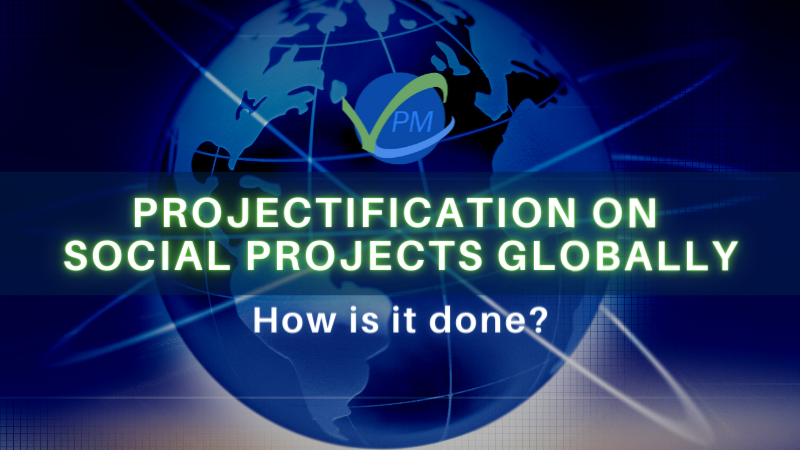
Projectification on social projects globally – How is it done? – Project Economy Series – Part 4
- Implementing public policies through projects is driven through global organizations such as World Bank, UNICEF, UN, etc., encouraging projectification practices that drive down activities vertically deep down.
- Implementation and deployment of public policies are time-framed. Hence, they are projectified.
- Projectification is seen as a key strategic measure for getting things done concerning the EU.
- OpenPM² is a project management methodology designed by the European Commission for interoperability solutions for public administrations, businesses, and citizens.
- We introduce projects to the public sector managers’ toolkit in the smallest offices and teach how to build project portfolios in the largest public units.
- The Polish public sector used the external funds and started to fully “think project-wise.” Because projectification of activities was a “sine qua non” condition, none of the countries joining the EU structures can fully integrate with them if there are no competencies regarding project management.
- To receive and implement a project, people have to organize themselves into teams – so projects build micro-communities and unite people around a common goal, often involving stakeholders who have so far been excluded.
Models such as GPM3 can help manage the implementation and evaluation of projectification efforts and their maturity, as given in the figure below.

Governmental Project Management Maturity Model (GPM3®)
Governmental Project Management Maturity Model (GPM3®)
A maturity model is the sequence of groups (levels) of more efficient practices in any activity area. Our base area for defining maturity levels are Governmental Project Implementation and Governmental Project Management treated together as one system. The first source of our inspiration was Capability Maturity Model Integrated (CMMI ©) – probably the first widely recognized and probably best-known maturity model. The second source of inspiration was the Organizational Project Management Maturity Model (OPM3©) – a maturity model for the organizational level.
Initial Level
Some governments are (really!) not interested in managing their projects and investments. They think it is enough to allocate the budget and set the deadline for product delivery, and people will know how to do it. We say about such governments that they are at the lowest, Initial level of project management maturity.
Local Level
At some moment, people in individual governmental agencies and organizations, worried about continuous failures of their projects and inefficient work, learn that efficient and effective project management methods exist. After some time, they manage to convince their organization executives that it is worth implementing them throughout the organization. If project management methods are implemented only in some governmental organizations, we say that the given government has reached the Local level of project management maturity.
Governmental Level
After some time, the cabinet learns that a few of its projects (either internal or foreign governments) were implemented more efficiently than anywhere else. This awareness resulted in implementing project management methods, techniques, and processes to work in all government projects. This way, project management maturity in that state reaches the Governmental level.
Cooperating Level
But should the government only define the ways of project implementation and passively observe the results of these processes? It is better if the government is actively involved in implementing projects, like trying to solve problems faced by – usually complex and complicated – government projects. Then we say that governmental project management has reached the Cooperating level.
Optimizing Level
But this is not the end of the journey to the top of the ladder of maturity. Everything can always be done better (if there is such a need). The most advanced governments – such as the US Federal Government – command its ministries and agencies to improve project (and program) management processes constantly. Then we say that the given government has reached the Optimizing level of project management maturity. And this description of progressively achieved levels of project management maturity (which can be observed in some countries) is called the Government Project Management Maturity Model (GPM3®).

Think global, Act local
Think global Act local: Committed project management individuals are experts at acquiring funding and coordinating support for their solution. In terms of projectification, these characteristics of the project champion are skills that are disseminated and encouraged across local government organizations. These Project Managers need to have the skills to cut across culture, language and have the ability to influence the groups for projectification.
Involve in fieldwork to get closer
- Connect with the local people at the ground level and understand the ground situation better for such implementations.
- Observe in the meeting and participate in meetings based on the dynamics involved with civil servants in different departments.
- Be available at the field level to have empathy towards the problem in projectification.
The more you become closer to them, the better operational goodness.

Fieldwork
Projectifications impact on BaU (Business as Usual)
- Activities are organized and realized as projects.
- Projects are the new form of work and mechanism for change.
- Enforcing the way of projectification through regulations, framework, and practices
- Projects in the public sector impact governance and help adopt previous best practices.
- Helps to identify and pilot a new way of work
- Helps developing new strategies and shaping the future for the society through innovation and joint learning, and
- In some cases, organizations might use projects for dealing with controversial issues that the permanent organization does not want to deal with.
Conclusion
In the global setting, Projectifications provide organizations with the ability to link multiple business partners and respond quickly to market demand and supplier needs while remaining flexible enough to anticipate and respond to rapid shifts in consumer preferences. The positive impact has been proven, so countries and its government need to enable the Civil Servants to become better project management and program management professionals for seamless projectification. This move would lead to a better economy, GDP and generate an extraordinary value stream across the government services.
Feel free to check out my discussion on this topic with Dr. Reinhard Wagner in YouTube
You can subscribe and follow my podcasts and interviews with Project Management Experts on YouTube at https://bit.ly/2NDY8wd
You can subscribe to vCare Project Management YouTube Channel to catch future videos of our certification Q&A series and student success stories using the link https://bit.ly/2YF0wJl
For any questions related to Project Management career, training, and certifications, you can book an obligation free 15 minutes session with me by visiting talktodharam.com


Recent Comments